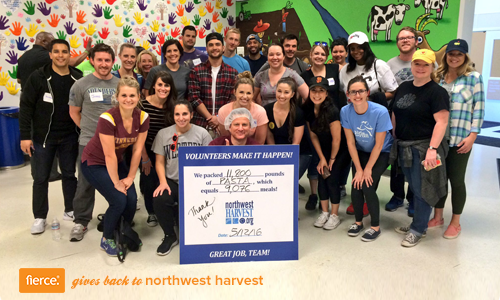Susan Scott's Blog, page 45
November 23, 2016
A Thanksgiving Conversation

Tomorrow is Thanksgiving in the United States, and for many, it is full of traditions. At our office, we had a Fiercegiving potluck yesterday, and over the lunch table, we were talking about our favorite dishes and traditions.
For me, every Thanksgiving dinner, my family starts a conversation with the same question. We go around the table and ask: what are you most thankful for?
Everyone is expected to participate and contribute. There is no “pass” to answering the question.
As a young girl in my booster seat, my answers usually involved extreme gratitude for my Barbies, the cranberry sauce, my cat – naturally, all of things that made my world so sweet and fun.
As the years have passed, my answers shifted to being thankful for living in the same city as my family, for my health, for creating silly memories together, and for sustaining the traditions we have. The answers change over the years…because I do.
With Thanksgiving tomorrow, I am excited to share the same, warm question with our family and guests. This beautiful ritual my family and I cherish is, in actuality, a very simple conversation. It allows us to check-in with ourselves and one another. It is a way to share how we’ve grown or changed and how our gratitude has shifted accordingly – from Barbies to creating memories. This conversation is a connecting point for us.
What traditions do you have around conversations? I really want to know!
And if you don’t have one, perhaps you can ask: What are you most thankful for?
This blog was originally published November 27, 2011 by Stacey Engle, EVP of Marketing.
The post A Thanksgiving Conversation appeared first on Fierce, Inc..
November 21, 2016
Fierce Tip of the Week: Foster Gratitude Together

Last week I was at Ernst & Young’s Strategic Growth Forum, where CEOs and executives came together to talk about new trends in business. Specifically, the theme was growth requires ingenuity. In the sessions, the topics ranged from business effects of the current American election to overcoming funding challenges to leading with purpose. It was inspiring, and many of the entrepreneurs stated gratitude for their opportunities, peers, and successes.
Showing gratitude was a common theme. Interestingly, a 2015 study published in the International Business Research journal showed that collective gratitude is important for organizations. What do they mean by collective gratitude? They defined it as “group’s shared positive emotional state recognizing and being thankful for the good things happen”.
When organizations are collectively grateful, it can reduce turnover intention, foster employees’ organizational commitment, and help in “eliminating the toxic workplace emotions, attitudes and negative emotions such as envy, anger and greed in today’s highly competitive work environment.”
We all want this in our workplace. Given that, this week’s tip is to share your gratitude with your colleagues and employees together with the goal of creating a community around appreciation.
If interested, you can use an exercise called: Gratitude on the Spot. In an upcoming meeting, set aside some time for the group to focus on gratitude. Have each person on your team or in a project group stand up for two minutes while colleagues say out loud what they appreciate about the person standing. Have a timekeeper that makes sure you stay on track, so everyone else can focus on the task at hand.
Why? The importance of appreciating team members publicly is vital. By taking the time to do this, you are signaling to the larger group or organization that you value appreciating others.
How will you share your gratitude together?
The post Fierce Tip of the Week: Foster Gratitude Together appeared first on Fierce, Inc..
November 18, 2016
Friday Resource: 4 Ways Your Company Benefits From Giving Back

This week’s Fierce resource was originally published by Entrepreneur and showcases four ways that a company can benefit from giving back to the community.
Although charitable acts are supposed to be made for selfless reasons, without the anticipation of a return on investment, there are rewards for businesses that give back.
Per John Boitnott, Entrepreneur Contributor, some of the ways companies can gain from giving back include:
1. Building respect and a good reputation in the community. The relationships formed through giving back to local organizations can add great value to businesses. When other people and businesses see the positive impact of charitable efforts, they want to support the company. Goodwill can go a very long way, and solidify a business as a steward to the community.
2. Improving the community. It goes without saying that giving back to the local community makes it a better place to work and live. Not only are businesses making a better name for themselves, they are making their home a better place. Whether it is parks they frequent, or the schools their children attend, donating locally has direct impact.
3. Employees respect leaders who do good. Employees respond deeply to company values and what the leadership at their company does. It is more important than ever to lead by example. With employee engagement low across the board, employees need motivation, and good morale can go a long way.
To find out Boitnott’s fourth reason to give back, real the full article.
The post Friday Resource: 4 Ways Your Company Benefits From Giving Back appeared first on Fierce, Inc..
November 16, 2016
Holding Back? 3 Tips to Foster More Feedback

Feedback. We all want it, and we rarely get enough of it. Feedback taps into our emotional desire to be seen. We crave it.
When I feel like I am not giving or receiving enough feedback, I check in. Sometimes I am scared – about what the end result will be. However, I know if I don’t hear or say what I need to – I am missing an opportunity.
And sometimes it truly surprises me. During one of my regular one-on-one meetings with a team member, I asked for feedback. She immediately responded with, “I want more feedback.” My response, “Perfect – let’s talk about that.” We then had a conversation about what feedback meant and looked like for each of us. Sometimes it is that easy to take the first step.
Here are three tips to create more feedback around you:
1. You never know until you ask. Like I shared, the old adage is true here. Ask for feedback. Don’t assume that it will magically appear on your office desk or your kitchen table for that matter. It is nice when it does, but hoping is never a strategy. Ask the people most important to you for feedback – the good, the bad, the ugly. It is all a gift. It does start with you here.
2. Don’t judge a book by its cover. Get curious about what feedback means to people around you. Ask about people’s preferences. In meetings with team members, ask them specifically how they prefer to receive feedback. Some may want group critique – some private. Some may want verbal – some written. Make sure to listen and deliver it the way they prefer.
3. Affirm me, please. Positive feedback is often overlooked. Don’t hold it in. Go there. Give your team members positive feedback and make it specific. In our Fierce Feedback model, we emphasize the importance of giving concrete, specific examples of what is done well. Instead of saying “You did a great job at that meeting” – be pointed and say “The way you handled the concern about our delivery time was very thoughtful and showed you did your research. Great work.” See the difference?
There is a lot to gain when we have more feedback conversations – both personally and company-wide. In fact, research by Gallup shows that companies who implement regular employee feedback have turnover rates that are 14.9% lower than for employees who receive no feedback.
How are you going to start?
This blog was originally published October 1, 2014 by Stacey Engle, EVP of Marketing.
The post Holding Back? 3 Tips to Foster More Feedback appeared first on Fierce, Inc..
November 14, 2016
Fierce Tip of the Week: Stop Stalling, It’s Time to Give Back

When I talk with people in my network, they often say they want to give back more – give their time, their money, their expertise. But…they aren’t organized around it. Or…other things come up. Or…there are just too many options. And then, nothing happens.
Well, now is the time to put some process around it and give back! Tomorrow is National Philanthropy Day. The day is meant to be a celebration of philanthropy—giving, volunteering and charitable engagement—that highlights the accomplishments, large and small, that philanthropy—and all those involved in the philanthropic process—makes to our society and our world.
So, I ask: Are you giving back to your community at your desired capacity?
This week’s tip is to create a plan, if you aren’t. It doesn’t have to be in the form of dollars. There are so many ways to give back:
Mentor a young person at your companyDonate time at a local food bank or shelterOffer to help someone in your neighborhood in needIf you are a leader, consider giving back together as your next team bonding event. UnitedHealth conducted research that shows 64 percent of employees who do volunteer work found their workplace relationships were strengthened by the experience. It is a great way to add value all around!
How do you currently give back to your community? How will you in the future?
The post Fierce Tip of the Week: Stop Stalling, It’s Time to Give Back appeared first on Fierce, Inc..
November 11, 2016
Friday Resource: Using Emotional Intelligence Is a Woman Leader’s Secret Weapon

This week’s Fierce resource was originally published by Forbes.com and explains why using emotional intelligence is a woman leader’s secret weapon.
In the article, LaRae Quy, former FBI counterintelligence agent talks about the role emotional intelligence (EQ) played in her career advancement within the FBI. Unlike many of her colleagues, Quy advanced her career and became an organizational leader by having a strong voice, not the loudest. Quy’s deviation from the FBI norm – tactics including aggressive, bullying behavior that relies heavily on intimidation to be effective allowed her to be extremely successful in her role. “Loud, boisterous, and pushy behavior may get attention, but it certainly does not get respect.”
Quy provides four reasons emotional intelligence can be a woman leaders most powerful tool. Two are:
Women Have Permission to Be Emotionally Intelligent; Men, Not So Much“Women in the workforce need to grab success however they can, but too many of them are throwing away their advantages by trying to be like men.”
Women Executives Rank Highest in Emotional Intelligence“It is believed that women often face barriers throughout their careers that require them to develop emotional intelligence skills they need to advance in their organizations.”
Quy goes on to provide some interesting insights into the science and research behind whether women or men have stronger natural tendencies towards emotional intelligence.
To find out the other two reasons emotional intelligence can be a woman leaders most powerful tool, read the full article.
The post Friday Resource: Using Emotional Intelligence Is a Woman Leader’s Secret Weapon appeared first on Fierce, Inc..
November 9, 2016
Post Election Hangover? A Challenge for You.

Do you have a post-election hangover? There is a good chance you do. And, there is also a good chance that you are in the office with someone who feels differently than you do about the outcome of the election. It can feel awkward to interact with that person, especially if you engaged in prior discussions around your choices.
This scenario of not seeing eye-to-eye is likely to pop up in all different scenes in your life – the office, school, church, grocery store, etc. The reality is, it is easy to point the finger. To disagree. To shut out. It is much harder to entertain an idea that competes with your own. To be curious. To be open.
Given that, I wanted to share an excerpt from Fierce’s Founder, Susan Scott in Fierce Conversations: Achieving Success at Work & in Life, One Conversation at a Time:
What each of us believes to be true simply reflects our views about reality. When reality changes (and when doesn’t it?) and when we ignore competing realities, if we dig in our heels regarding a familiar or favored reality, we may fail. Perhaps what we thought was the truth is no longer the truth in today’s environment.
For example, most people believe that there are some people you just can’t talk to. That, as Satchmo said, “Some people, if they don’t know, you can’t tell them.” After we’ve experienced countless failed conversations over the years, such a belief is understandable.
I’ve observed, however, that it is also possible that the way we’ve been talking with people isn’t working. That our techniques for talking with “difficult” people haven’t worked, but other techniques can and do work, without rattling sabers or giving ultimatums. That is our beliefs about what we can say, as well as how and to whom we can say it, that are in the way, and that if we change our beliefs, productive conversations can easily occur.
Today, the day after US Election Day, I challenge you to stretch your beliefs and assumptions. Only when you dig deeper and explore where you are coming from, will you truly be able to talk openly.
And now we, as Americans, must start repairing the damage this election cycle has created. We must nurture our relationships, our expectations, our respect for each other. And we need to, one conversation at a time.
It starts with you. And your beliefs.
The post Post Election Hangover? A Challenge for You. appeared first on Fierce, Inc..
November 7, 2016
Fierce Tip of the Week: Build Emotional Capital

Emotional intelligence (EQ) is awareness of yourself and your impact on others around you. EQ allows you to build relationships and drive results.
Kendra Cherry, a psychology expert, discusses the differences between IQ and EQ in her article “IQ or EQ: Which One Is More Important?” She cites research that shows EQ plays a bigger role than a person’s intelligence in determining their success or failure at work. In fact, TalentSmart tested emotional intelligence alongside 33 other important workplace skills, and found that EQ is the strongest predictor of performance,
When considering this fact, your ability to have conversations with emotions and increased understanding is not a soft skill. It is directly correlated to the results you achieve…or don’t. And it’s a significant factor.
This week’s tip is to build emotional capital with people important to you. Avoid taking a withdrawal from people’s emotional bank accounts, and instead, focus on making deposits.
Simple ways to make a deposit:
Share positive feedback.Ask a question, and really listen for the answer.Surprise someone with a handwritten note.Call out of the blue.The benefit of making deposits is that the returns will be greater than you can even anticipate.
The post Fierce Tip of the Week: Build Emotional Capital appeared first on Fierce, Inc..
November 4, 2016
Friday Resource: 6 Ways to Conquer the Fear of Confrontations

This week’s Fierce resource was originally published by Forbes.com and provides six ways to conquer fear of confrontation.
Whether we like to admit or not, most of us are guilty of avoiding a conversation that we know will be difficult. Excuses enter our heads, like “not wanting to rock the boat,” and we convince ourselves that things will eventually change. Wrong.
Whether it is a work conflict or a relationship issue, you owe it to yourself (and the other person) to have the difficult conversation to move the relationship forward.
Amy Morin, psychotherapist and Forbes contributor, shares some effective ways of overcoming a fear of confrontation:
Identify the problems with being a pushover. It is difficult for someone to change behavior if they do not see how it is negatively affecting them. Writing down all the problems you experience by avoiding confrontation can help you understand the impact it has on your life.Reconsider the assumptions you make about confrontation. Most fears about confrontation stem from incorrect assumptions. Thinking that a confrontation conversation will ruin a relationship or make things painfully awkward only fuels more fear. The relationship will most likely be enhanced by having the conversation in the end.Address one small issue at a time. If you have been avoiding several issues with a colleague or friend, identify a minor issue to start the conversation. More than likely, it will go well and you will have confidence to address the meatier issues down the road.To discover the rest of the tips, read the entire article.
The post Friday Resource: 6 Ways to Conquer the Fear of Confrontations appeared first on Fierce, Inc..
November 2, 2016
Two Reminders to Take the Scare out of Your Conversations

There are legitimate reasons to be scared about having some conversations. Let’s be honest – some people do not react well when confronted, regardless of how eloquent and thoughtful you are. Sometimes, certain discussions are not career-enhancing, depending on your colleagues and boss. This is reality.
However, what is also reality is that the cost of not having the conversation is much greater than the risk of it going badly. These needed conversations weigh you down. You know this. Science tells you this.
So, here are two tips to overcome the scary nature of some exchanges:
Prepare accordingly. Whether it is a feedback or confrontation conversation, preparation is key for having the conversation align with your intention. Here at Fierce we teach the preparation piece for various conversations, and oftentimes, people tell us that it is our magic. The goal is to make your conversations authentic and drive the results you want. So, prepare by scanning some of the tips from this blog. Set aside some unadulterated time to focus and think through the conversation. Take some notes.Practice with someone. Many conversations do not go the way we want them to, because we are not clear and direct. Once you have done some preparation, find a friend or partner to practice with. Ask the person how they felt with your delivery. Ask for feedback. It is not necessary to do a role play situation, but rather, use the practice time as an opportunity to make sure you are not laying blame or using inflammatory language that could trigger just about anyone.These tips are not new. They serve as a reminder, though. And ultimately, you are the one that must make the choice to have the conversation.
And for your own sake, I really hope you do. You have more to gain than you can imagine.
Do you have any tips for our audience about dealing with fear around conversations?
The post Two Reminders to Take the Scare out of Your Conversations appeared first on Fierce, Inc..
Susan Scott's Blog
- Susan Scott's profile
- 859 followers



